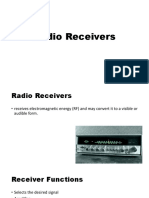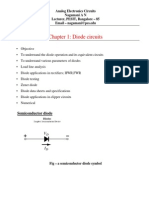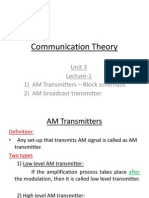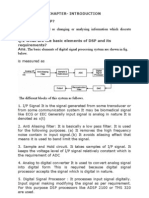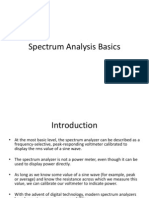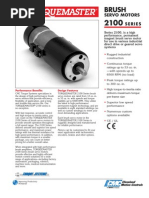0 ratings0% found this document useful (0 votes)
101 viewsAnalog Communication
This document provides an overview of analog communication and AM receivers. It discusses topics such as AM and FM waves, modulation index, AM and FM comparison, radio receiver parameters like sensitivity and selectivity, the superheterodyne receiver structure including RF amplifier, mixer, IF section, and detector. It also describes the AM receiver RF amplifier, mixer, detector and AGC circuits in detail. The document is intended to review key concepts in analog communication systems.
Uploaded by
sou RCopyright
© © All Rights Reserved
Available Formats
Download as PDF, TXT or read online on Scribd
0 ratings0% found this document useful (0 votes)
101 viewsAnalog Communication
This document provides an overview of analog communication and AM receivers. It discusses topics such as AM and FM waves, modulation index, AM and FM comparison, radio receiver parameters like sensitivity and selectivity, the superheterodyne receiver structure including RF amplifier, mixer, IF section, and detector. It also describes the AM receiver RF amplifier, mixer, detector and AGC circuits in detail. The document is intended to review key concepts in analog communication systems.
Uploaded by
sou RCopyright
© © All Rights Reserved
Available Formats
Download as PDF, TXT or read online on Scribd
You are on page 1/ 51
Analog Communication
Module I
Jerry Kuriakose Analog Communication 1
Review of AM & FM
Jerry Kuriakose Analog Communication 2
FM & PM
Jerry Kuriakose Analog Communication 3
AM Spectrum
Jerry Kuriakose Analog Communication 4
AM Wave
Jerry Kuriakose Analog Communication 5
FM Wave
• For FM wave, modulation Index,
• m is greater than or equal to 1
• For AM, m is always between 0 and 1
Jerry Kuriakose Analog Communication 6
AM-FM Comparison
AM FM
Modulating Carrier wave is modulated in amplitude Carrier wave is modulated in frequency by
differences by the signal that is to be transmitted. the signal that is to be transmitted. The
The freq and phase remain the same. amplitude and phase remain the same.
Frequency 540 to 1650 KHz 88 to 108 MHz
Range
Bandwidth Twice the highest modulating frequency. Twice the sum of the modulating signal
Requirement In AM radio broadcasting, the frequency and the frequency deviation. If
s modulating signal has bandwidth of the frequency deviation is 75kHz and the
15kHz, and hence the bandwidth of an modulating signal frequency is 15kHz, the
amplitude-modulated signal is 30kHz. bandwidth required is 180kHz.
Pros and cons AM has poorer sound quality compared FM is less prone to interference than AM.
with FM, but is cheaper and can be However, FM signals are impacted by
transmitted over long distances. It has a physical barriers. FM has better sound
lower bandwidth so it can have more quality due to higher bandwidth.
stations available in any frequency range.
Jerry Kuriakose Analog Communication 7
Radio receivers
• Several parameters are commonly used to evaluate the ability
of a receiver to successfully demodulate a radio signal. The
most important parameters are Selectivity, sensitivity and
fidelity
• Sensitivity indicates the ability of a radio receiver to amplify
weak signals
• Selectivity is a parameter used to measure the ability of a
receiver to accept a given desired band of frequencies, while
rejecting others.
• Fidelity is a measure of the ability of a communication system
to produce at the output of the receiver an exact replica of the
original source information.
Jerry Kuriakose Analog Communication 8
Superheterodyne AM Receiver
Jerry Kuriakose Analog Communication 9
Superheterodyne AM Receiver
• Heterodyne means to mix two frequencies together in a non
linear device or to translate one frequency to another using non
linear mixing.
Jerry Kuriakose Analog Communication 10
Superheterodyne AM Receiver
• RF Section
• Consists of preselector and an amplifier stage
• Preselector-broad tuned bandpass filter with an adjustable
centre frequency that’s tuned to the desired carrier frequency.
• Purpose of Preselector
• a) to provide initial band limiting to prevent a specific
unwanted frequency from entering the receiver(image
frequency)
• b) to reduce the noise bandwidth of the receiver, thus
providing initial step towards reducing the overall receiver
bandwidth required to pass the desired radio frequency signals.
Jerry Kuriakose Analog Communication 11
Superheterodyne AM Receiver
• RF Amplifier
• Determines the sensitivity of the receiver. A receiver can have
one or more amplifiers depending on the desired sensitivity.
• Advantages of including amplifiers at the RF stage
• Greater gain.
• Better selectivity.
• Improved image frequency rejection ratio.
• Better signal to noise ratio.
Jerry Kuriakose Analog Communication 12
Superheterodyne AM Receiver
• Mixer/Converter Section
• This includes a RF oscillator called Local Oscillator & a mixer
• The Local Oscillator can be any of the oscillator circuits
(Hartley, Colpitts, Crystal etc)
• Mixer is a non linear device which converts the radio
frequency to intermediate frequency (RF to IF translation).
Heterodyning takes place in the mixer stage.
• Although carrier & sidebands are converted from RF to IF, the
shape of AM envelope remains the same, and therefore the
original information contained in the envelope remains
unchanged. Most common IF for AM receiver is 455KHz.
Jerry Kuriakose Analog Communication 13
Superheterodyne AM Receiver
• IF Section
• Consists of a series of IF amplifiers & band pass filters
• Most of the gain & selectivity is achieved in this section
• IF centre freq & bandwidth is constant for all stations
• Need for an IF section
• it is easier & less expensive to construct high gain stable
amplifiers for low frequency signals
• low freq IF amplifiers are less likely to oscillate compared
to their RF counterparts
Jerry Kuriakose Analog Communication 14
Superheterodyne AM Receiver
• Audio Detector Section
• To convert IF signals back to the original source information
• Can be as simple as a diode detector or as complex as a
balanced detector.
• Audio Amplifier section
• Comprises of several cascaded audio amplifiers & one or more
speakers
• The number of audio amplifiers used depends on the audio
signal power desired
Jerry Kuriakose Analog Communication 15
Superheterodyne AM Receiver
• Ganged Tuning
• The converted freq from mixer is wIF. Whatever be the input
from RF filter, output of mixer is always wIF.
• We have to make sure that the RF filter & Local oscillator
should be tuned together so that if RF filter is tuned to a
different frequency, Local oscillator should also generate that
freq ±wIF. If RF filter changes tuning from wc to w2, Local
oscillator should produce w2 ±wIF instead of wc ±wIF . As RF
Filter is tuned, LO should also be tuned. The tuning is
typically ganged up. Tuning of the two happens together
through a ganged up set of capacitors.
Jerry Kuriakose Analog Communication 16
AM Receiver - RF Amplifier
• RF Amplifiers
Jerry Kuriakose Analog Communication 17
AM Receiver - RF Amplifier
• RF Amplifier is a small signal tuned amplifier with tuned
circuits at input & output side. Both tuned circuits are tuned to
the desired incoming signal freq. so the tuned circuits select
the desired signal freq & reject all other unwanted freq
including the image freq.
• Gain provided by the RF amplifiers results in improved SNR
at the output of receiver
• Signal received at received antenna is transformer coupled to
the base of transistor. Input tuned circuit is tuned to the desired
carrier freq with the help of ganged tuning. Amplified signal
developed across the collector of transistor is coupled through
a step down transformer to the next stage
Jerry Kuriakose Analog Communication 18
AM Receiver - RF Amplifier
• Advantages of including RF Amplifiers
• greater gain (so better sensitivity)
• improved image frequency rejection (so better selectivity)
• improved SNR
• improved coupling of signals from antenna to later stages
of receiver.
Jerry Kuriakose Analog Communication 19
AM Receiver - Mixer
Jerry Kuriakose Analog Communication 20
AM Receiver - Mixer
• Mixer
• To down convert incoming RF signals to IF signals
• A mixer is similar to a non linear amplifier except that its
output is tuned to the difference frequency.
• RF signal from the antenna are filtered by the preselector
tuned circuit & then transformer coupled to the base of Q1. Q1
provides amplification for the local oscillator (LO). This
configuration is called self excited mixer because the mixer
excites itself by feeding energy back to the LO tank circuit (C2
& L2) to sustain oscillations
Jerry Kuriakose Analog Communication 21
AM Receiver - Mixer
• The LO frequency is the resonant freq of the tank circuit. A
portion of the resonant tank circuit energy is coupled through
L2 & L5 to the emitter of Q1. This signal drives Q1 into its non
linear operating region & consequently produces sum &
difference frequencies at its collector. The difference freq is
the IF. The output tank circuit (C3 & L3) is tuned to the IF
band. The IF signal is transformer coupled to the input of first
IF amplifier
Jerry Kuriakose Analog Communication 22
AM Receiver - Detector
Jerry Kuriakose Analog Communication 23
AM Receiver - Detector
• Diode is the common device used for AM demodulation or
detection.
• The parallel combination of R & C is the load resistance across
which the rectified output voltage Vo is developed. At each
positive peak of input cycle C charges up to a potential almost
equal to the peak signal voltage Vs.the time constant of RC
combination must be slow enough to keep the RF ripple as
small as possible, but sufficiently fast for detector circuit to
follow the fastest modulation variations.
Jerry Kuriakose Analog Communication 24
AM Receiver – AGC Circuits
Jerry Kuriakose Analog Communication 25
AM Receiver – AGC Circuits
• The AGC circuit automatically increases the receiver gain for
weak RF input levels & automatically decreases the receiver
gain when a strong RF signal is received. Weak signals can be
buried in receiver noise and may be impossible to detect. An
excessively strong signal can overdrive the RF/IF amplifiers
and produce excessive non linear distortion & even saturation.
• The AGC circuit monitors the received signal level & sends a
signal back to the RF & IF amplifiers to adjust their gain
automatically. The purpose of AGC is to allow a receiver to
detect & demodulate, signals that are transmitted from
different stations whose output power & distance from
receiver vary
Jerry Kuriakose Analog Communication 26
AM Receiver
• An AGC circuit is essentially a peak detector. The circuit
shows a negative peak detector. The greater the amplitude of
input carrier, the more negative the output voltage. The
negative voltage from the AGC detector is fed back to the IF
stage, where it controls the bias voltage on the base of Q1.
When the carrier amplitude increases voltage on the base of Q1
becomes less positive, causing the emitter current to decrease
which in turn decreases the gain.
• When the carrier amplitude decreases, AGC voltage becomes
less negative, emitter current increases and amplifier gain
increases.
Jerry Kuriakose Analog Communication 27
FM Reactance Modulator (JFET)
• s
Jerry Kuriakose Analog Communication 28
FM Reactance Modulator (JFET)
• The circuit is called reactance modulator, because the JFET
looks like a variable reactance load to the LC tank circuit. The
modulating signal varies the reactance of Q1, which causes a
corresponding change in the resonant frequency of the
oscillator tank circuit.
• When a modulating signal is applied to the bottom of R3, the
gate to source voltage is varied accordingly, causing a
proportional change in circuit impedance. So the resonant
frequency of the oscillator tank circuit is a function of the
amplitude of the modulating signal.
Jerry Kuriakose Analog Communication 29
FM Reactance Modulator (BJT)
• s
Jerry Kuriakose Analog Communication 30
FM Reactance Modulator (BJT)
• The circuit is a standard class A common emitter amplifier
with two external inputs – modulating signal input and
external carrier input.
• The transistor emitter to collector resistance is a part of the
phase shifter consisting of C1 in series with Rt & emitter
resistor RE.
• Output is taken across series combination of Rt & RE.
• The circuit is designed such that at the carrier input frequency,
sum of Rt & RE equals capacitive reactance of C1, the carrier
input signal is shifted 45o.
Jerry Kuriakose Analog Communication 31
FM Reactance Modulator (BJT)
• When modulating signal is applied, its voltage adds and
subtracts from the dc base bias, producing corresponding
changes in collector current. Changes in collector current
changes emitter to collector resistance, producing changes in
phase shift that the collector undergoes as it passes through the
phase shifting network. The phase shift is directly proportional
to the amplitude of the modulating signal.
• Higher the amplitude of the modulating input signal, greater
the change in emitter to collector resistance and greater the
phase shift.
Jerry Kuriakose Analog Communication 32
Armstrong FM Modulator
Jerry Kuriakose Analog Communication 33
Armstrong FM Modulator
• With indirect FM, the modulating signal directly deviates the
phase of the carrier, which indirectly changes the frequency.
• A relatively low frequency subcarrier is phase shifted 90o &
fed to a balanced modulator, where it is mixed with the input
modulating signal.
• Output of modulator is a DSBSC wave which is combined
with the original carrier to produce a phase modulated
waveform.
• Since the DSBSC wave is 90o out of phase with the carrier
(Vc), the lower & upper sidebands combine to produce a
component (Vm) that is always in quadrature with Vc
Jerry Kuriakose Analog Communication 34
Armstrong FM Modulator
Jerry Kuriakose Analog Communication 35
Armstrong FM Modulator
• The peak phase deviation can be calculated as
• Ɵ = m = arctan(Vm/Vc)
• For very small angles, tangent of angle is equal to the angle.
• So Ɵ = m = (Vm/Vc)
• Change in modulating voltage can cause change in the phase,
which in turn causes frequency variation.
Jerry Kuriakose Analog Communication 36
Armstrong FM Modulator
• For a modulating signal with freq of 15KHz & amplitude of
0.0048V, the Armstrong modulator works as follows.
• The maximum phase deviation is
• Ɵ = m = arctan(Vm/Vc) = 1.67 milli radians
• Freq deviation, Δf = mfm
• Δf max = 0.00167 * 15000 = 25Hz
• A combination of multiplying & mixing is necessary to
develop the desired transmit carrier freq with 75KHz freq
deviation.
Jerry Kuriakose Analog Communication 37
Armstrong FM Modulator
• The output of a combining network is multiplied by 72
producing
• f1 = 72*200 KHz = 14.4MHz
• m = 72*0.00096 = 0.06912 rad
• Δf = 72 *14.4Hz = 1036.8Hz
• The output from multiplier is mixed with a 13.15MHz crystal
controlled freq to produce a diff signal having
• f2 = 14.4MHz – 13.15MHz =1.25 MHz
• m = 0.06912 rad
• Δf = 1036.8Hz
Jerry Kuriakose Analog Communication 38
Armstrong FM Modulator
• The output from mixer is once again multiplied by 72 to
produce a transmit signal with following characteristics
• ft = 72*1.25 MHz = 90MHz
• m = 72*0.00096 = 4.98 rad
• Δf = 72 * 1036.8Hz = 74650Hz
Jerry Kuriakose Analog Communication 39
FM Superheterodyne Receiver
• s
Jerry Kuriakose Analog Communication 40
FM Receiver – Simplified Block
Diagram
• s
Jerry Kuriakose Analog Communication 41
FM Superheterodyne Receiver
• The preselector, RF amplifier & the two mixer circuits perform
the same function as they did in AM receivers.
• The preselctor rejects the image freq, the RF Amplifier
establishes SNR & noise figure, the mixer converts RF to IF,
IF amplifier provides most of the gain & selectivity of the
receiver.
• AGC is not used with FM receivers because with FM
transmission, there is no information contained in the
amplitude of the received signal.
• The final IF amplifier is specially designed for ideal saturation
characteristics and is called a limiter, or sometimes passband
limiter, if the output is filtered.
Jerry Kuriakose Analog Communication 42
FM Superheterodyne Receiver
• The envelope (peak) detector in AM receivers is replaced by a
limiter, freq discriminator & de-emphasis network. The
frequency discriminator extracts the information from the
modulated wave, while the limiter circuit & de-emphasis
network contribute to an improvement in the signal to noise
ratio.
• For broadcast band FM receivers, the first IF is relatively high
freq, (often 10.7MHz) for good image freq rejection & the
second IF is a relatively low freq (often 455KHz) that allows
the IF amplifiers to have a relatively high gain & still not
susceptible to oscillating. With a first IF of 10.7MHz, the
image freq for even the lowest possible FM station (88.1MHz)
is 109.5MHz, which is beyond the FM broadcast range.
Jerry Kuriakose Analog Communication 43
FM Demodulators - Slope Detector
Jerry Kuriakose Analog Communication 44
Slope Detector
• The tuned circuit (La & Ca) produces an output voltage that is
proportional to the input frequency. The maximum output
voltage occurs at the resonant frequency of the tank circuit (fo)
& its output decreases as the input frequency deviates above or
below fo. The circuit is designed so that the IF centre
frequency (fc) falls in the centre of the most linear portion of
the voltage versus frequency curve. When the intermediate
freq deviates above fc the output voltage increases & when the
intermediate freq deviates below fc the output voltage
decreases. So the tuned circuit converts freq variation to amp
variations. D,C & R makes up a peak detector that converts
amp variations to an output voltage that varies at a rate equal
to input frequency changes
Jerry Kuriakose Analog Communication 45
Balanced Slope Detector
Jerry Kuriakose Analog Communication 46
Balanced Slope Detector
• The circuit consists of two slope detector circuits connected in
parallel & fed 1800 out of phase. The tuned circuits(La, Ca and
Lb, Cb) perform the FM to AM conversion, and the balanced
peak detectors (D1,C1,R1 & D2,C2,R2 ) remove the information
from the AM envelope.
• The top tuned circuit (La, Ca )is tuned to a frequency (fa) that is
above IF centre freq & lower tuned circuit (Lb, Cb) is tuned to
a frequency (fb) that is below IF centre freq by an equal
amount.
• The output voltage from each tuned circuit is proportional to
the input frequency & each output is rectified by its respective
peak detector
Jerry Kuriakose Analog Communication 47
Balanced Slope Detector
• Therefore the closer the input freq is to the tank circuit
resonant freq, the greater the tank circuit output voltage. The
IF centre freq falls half way between the resonant freq’s of the
two tuned circuits.
• So at IF centre freq, the output voltages from the two tuned
circuits are equal in amp, but opposite in polarity. So the
rectified output voltage when added produce a differential
output voltage, Vout = 0V.
• When the IF deviates above resonance, the top tuned circuit
produces a higher output voltage than lower tank circuit and
Vout goes positive. & vice versa.
Jerry Kuriakose Analog Communication 48
Ratio Detector
Jerry Kuriakose Analog Communication 49
Ratio Detector
• A ratio detector has a single tuned circuit in the transformer
secondary. After several cycles of input signal, the capacitor Cs
charges to approximately the peak voltage across the
secondary winding of T1.
• Rs simply provides a dc path for diode current. So the time
constant for Rs & Cs is sufficiently long so that rapid changes
in the amplitude of input signal due to thermal noise or other
interfering signals are shorted to ground & have no effect on
the average voltage across Cs. C1 & C2 charge & discharge
proportional to freq changes in input signal.
Jerry Kuriakose Analog Communication 50
Ratio Detector
• At resonance the output voltage is divided equally between C1
& C2 and redistributed as the input freq is deviated above or
below resonance.
• So changes in Vout are due to the changing ratio of the voltage
across C1 & C2, while the total voltage is clamped by Cs.
• At resonance Vout is not equal to 0V, but rather to one half of
the voltage across the secondary windings of T1.
Jerry Kuriakose Analog Communication 51
You might also like
- Commercial Building Standard For Telecom Pathway & SpacesNo ratings yetCommercial Building Standard For Telecom Pathway & Spaces58 pages
- Elements of Telecommunication: Frequency ModulationNo ratings yetElements of Telecommunication: Frequency Modulation41 pages
- Chapter Five: Introduction To Active Microwave Devices and NetworksNo ratings yetChapter Five: Introduction To Active Microwave Devices and Networks38 pages
- Narrow-Band FM and Wide-Band FM: Presented by N.A.Pappathi Ap / Ece, NprcetNo ratings yetNarrow-Band FM and Wide-Band FM: Presented by N.A.Pappathi Ap / Ece, Nprcet32 pages
- Chapter 11: Wide Area Networks and The InternetNo ratings yetChapter 11: Wide Area Networks and The Internet12 pages
- Data Communication and Computer NetworksNo ratings yetData Communication and Computer Networks72 pages
- AM Transmission System: Emer Paolo Sidamon Christian Dave SantosNo ratings yetAM Transmission System: Emer Paolo Sidamon Christian Dave Santos45 pages
- RF Based Home Security System: Presented byNo ratings yetRF Based Home Security System: Presented by14 pages
- Unit of Measure - DB, DBD, DBi, DBM, DBW and DBMVNo ratings yetUnit of Measure - DB, DBD, DBi, DBM, DBW and DBMV8 pages
- Introduction To Capacitors: Electronics Tutorial About CapacitorsNo ratings yetIntroduction To Capacitors: Electronics Tutorial About Capacitors32 pages
- THE PUBLIC TELEPHONE NETWORK 18 1 To 18 9No ratings yetTHE PUBLIC TELEPHONE NETWORK 18 1 To 18 950 pages
- ch2 Introduction To Data Communications PDFNo ratings yetch2 Introduction To Data Communications PDF80 pages
- Unit 1 Fundamental Theory of Radiation and Radiating Elements 20_21.pptxNo ratings yetUnit 1 Fundamental Theory of Radiation and Radiating Elements 20_21.pptx184 pages
- Digital/Analog Migration IDAS™ Conventional IP Network IDAS™ TrunkingNo ratings yetDigital/Analog Migration IDAS™ Conventional IP Network IDAS™ Trunking8 pages
- ECEG-4281 Microelectronic Devices and Circuits (MDC)No ratings yetECEG-4281 Microelectronic Devices and Circuits (MDC)11 pages
- Basics of Antenna: Shunmugapriyan.M II Year M.E (Communication Systems)No ratings yetBasics of Antenna: Shunmugapriyan.M II Year M.E (Communication Systems)24 pages
- 1) Ec8701 Antennas and Microwave EngineeringNo ratings yet1) Ec8701 Antennas and Microwave Engineering35 pages
- Aman's Copy of DBMS 2 - Anomalies + NormalizationNo ratings yetAman's Copy of DBMS 2 - Anomalies + Normalization11 pages
- Doubt Clearing Session Percentage Part IV With AnnoNo ratings yetDoubt Clearing Session Percentage Part IV With Anno23 pages
- Doubt Clearing Session Percentage Part VIII With Anno NewNo ratings yetDoubt Clearing Session Percentage Part VIII With Anno New67 pages
- Start: Initialize Inclination Sensor (MMA7631) Initialize Temperture Sensor (LM35) Initialize Fuel SensorNo ratings yetStart: Initialize Inclination Sensor (MMA7631) Initialize Temperture Sensor (LM35) Initialize Fuel Sensor2 pages
- Study The Rheological and Mechanical Properties of PVANo ratings yetStudy The Rheological and Mechanical Properties of PVA7 pages
- Generac Doosan 22.0 Liter V12 Diesel 22.0DTA Generator Engine Parts ManualNo ratings yetGenerac Doosan 22.0 Liter V12 Diesel 22.0DTA Generator Engine Parts Manual63 pages
- Charin E.V. - The Way To A Global Standard: Sivam Sabesan, Managing Director IndiaNo ratings yetCharin E.V. - The Way To A Global Standard: Sivam Sabesan, Managing Director India25 pages
- LNG 6 - Safeguard Systems 7.3.09-Aacomments-Aug09No ratings yetLNG 6 - Safeguard Systems 7.3.09-Aacomments-Aug098 pages
- Ulusoy HMH24-04 Incoming/Outgoing Switchgear With Circuit Breaker User Manual100% (1)Ulusoy HMH24-04 Incoming/Outgoing Switchgear With Circuit Breaker User Manual16 pages
- Advances in Synthesis Gas: Methods, Technologies and Applications, Volume 4: Syngas Process Modelling and Apparatus Simulation 1St Edition-Ebook PDF100% (5)Advances in Synthesis Gas: Methods, Technologies and Applications, Volume 4: Syngas Process Modelling and Apparatus Simulation 1St Edition-Ebook PDF51 pages
- HL-01A Hydrogen Liquefaction - A Review of The Fundamental Physic, Engineering Practice and FutureNo ratings yetHL-01A Hydrogen Liquefaction - A Review of The Fundamental Physic, Engineering Practice and Future42 pages
- Burgmann Quick Guide To Identifying Mechanical Seal Failures100% (1)Burgmann Quick Guide To Identifying Mechanical Seal Failures1 page
- Degassing Spray Technology Sulfur Recovery - MDRNo ratings yetDegassing Spray Technology Sulfur Recovery - MDR3 pages
- Commercial Building Standard For Telecom Pathway & SpacesCommercial Building Standard For Telecom Pathway & Spaces
- Elements of Telecommunication: Frequency ModulationElements of Telecommunication: Frequency Modulation
- Chapter Five: Introduction To Active Microwave Devices and NetworksChapter Five: Introduction To Active Microwave Devices and Networks
- Narrow-Band FM and Wide-Band FM: Presented by N.A.Pappathi Ap / Ece, NprcetNarrow-Band FM and Wide-Band FM: Presented by N.A.Pappathi Ap / Ece, Nprcet
- AM Transmission System: Emer Paolo Sidamon Christian Dave SantosAM Transmission System: Emer Paolo Sidamon Christian Dave Santos
- Introduction To Capacitors: Electronics Tutorial About CapacitorsIntroduction To Capacitors: Electronics Tutorial About Capacitors
- Unit 1 Fundamental Theory of Radiation and Radiating Elements 20_21.pptxUnit 1 Fundamental Theory of Radiation and Radiating Elements 20_21.pptx
- Digital/Analog Migration IDAS™ Conventional IP Network IDAS™ TrunkingDigital/Analog Migration IDAS™ Conventional IP Network IDAS™ Trunking
- ECEG-4281 Microelectronic Devices and Circuits (MDC)ECEG-4281 Microelectronic Devices and Circuits (MDC)
- Basics of Antenna: Shunmugapriyan.M II Year M.E (Communication Systems)Basics of Antenna: Shunmugapriyan.M II Year M.E (Communication Systems)
- Modulation and Coding Techniques in Wireless CommunicationsFrom EverandModulation and Coding Techniques in Wireless Communications
- Doubt Clearing Session Percentage Part IV With AnnoDoubt Clearing Session Percentage Part IV With Anno
- Doubt Clearing Session Percentage Part VIII With Anno NewDoubt Clearing Session Percentage Part VIII With Anno New
- Start: Initialize Inclination Sensor (MMA7631) Initialize Temperture Sensor (LM35) Initialize Fuel SensorStart: Initialize Inclination Sensor (MMA7631) Initialize Temperture Sensor (LM35) Initialize Fuel Sensor
- Study The Rheological and Mechanical Properties of PVAStudy The Rheological and Mechanical Properties of PVA
- Generac Doosan 22.0 Liter V12 Diesel 22.0DTA Generator Engine Parts ManualGenerac Doosan 22.0 Liter V12 Diesel 22.0DTA Generator Engine Parts Manual
- Charin E.V. - The Way To A Global Standard: Sivam Sabesan, Managing Director IndiaCharin E.V. - The Way To A Global Standard: Sivam Sabesan, Managing Director India
- Ulusoy HMH24-04 Incoming/Outgoing Switchgear With Circuit Breaker User ManualUlusoy HMH24-04 Incoming/Outgoing Switchgear With Circuit Breaker User Manual
- Advances in Synthesis Gas: Methods, Technologies and Applications, Volume 4: Syngas Process Modelling and Apparatus Simulation 1St Edition-Ebook PDFAdvances in Synthesis Gas: Methods, Technologies and Applications, Volume 4: Syngas Process Modelling and Apparatus Simulation 1St Edition-Ebook PDF
- HL-01A Hydrogen Liquefaction - A Review of The Fundamental Physic, Engineering Practice and FutureHL-01A Hydrogen Liquefaction - A Review of The Fundamental Physic, Engineering Practice and Future
- Burgmann Quick Guide To Identifying Mechanical Seal FailuresBurgmann Quick Guide To Identifying Mechanical Seal Failures










